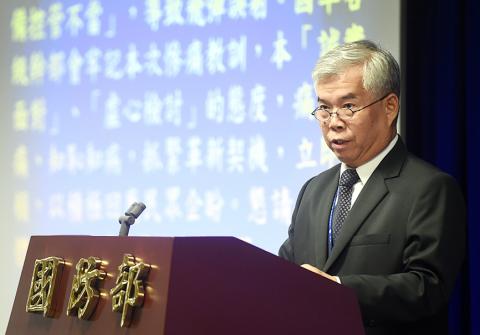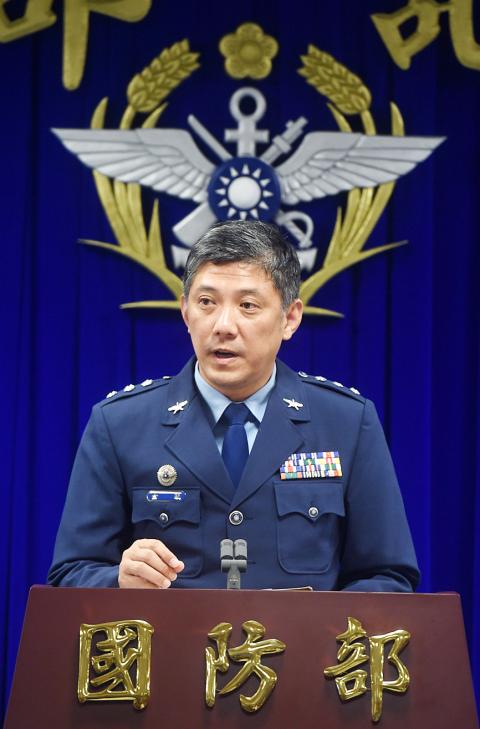The Ministry of National Defense (MND) yesterday released the results of its investigation into an accidental missile launch last month, saying a series of missteps and procedural violations caused the mishap.
A Hsiung Feng III supersonic anti-ship missile was accidentally launched from a Kaohsiung-based Chinchiang-class corvette ahead of a training exercise on July 1. The missile ripped through a fishing boat, killing the boat’s captain, Huang Wen-chung (黃文忠), and injuring three crew members.
The missile was launched because Petty Officer Second Class Kao Chia-chun (高嘉駿) accidentally connected unnecessary fire plugs — a connector assembly used to send launch orders, to a missile launcher — Navy Command Headquarters Chief of Staff Vice Admiral Mei Chia-shu (梅家樹) said.

Photo: Chien Jung-fong, Taipei Times
Kao was supposed to connect only two fire plugs, because safety devices were installed on only two of the ship’s four missiles, but he connected four, Mei said.
Kao’s supervisor, Chief Petty Officer Chen Ming-hsiu (陳銘修), should have requested only two fire plugs instead of four, while the ship’s weapon systems officers should only have given him two, Mei said.
Chen misunderstood orders for the drill, believing that all four missiles were to be prepared for the training exercise, but the exercise was only to simulate the launch of one missile, Mei said, adding that during a pre-drill rehearsal, Chen left the operations room after ordering Kao to establish two sets of firing solutions.

Photo: Chien Jung-fong, Taipei Times
According to protocol, Chen should have supervised Kao throughout the entire process, but Kao was left alone in the operations room as he went through the entire pre-launch process while rehearsing for the exercise, when he accidentally hit the launch button, Mei said.
“There were too many oversights and too much negligence. We are deeply distressed [by the incident], but we have made efforts to improve [launch procedures],” Mei said.
Asked how Chen could have misunderstood orders for the exercise, Mei said instructions were ambiguous, adding that the navy would make improvements.
“The missile system will also be redesigned to prevent accidental launches,” Mei said.
Ministry Inspector General Wu Pao-Kun (吳寶琨) said that the July 1 training exercise should not have been scheduled, because the ship’s commander had only been in command since April 11, while operational rules stipulate that such high-level drills are not allowed until a commander has been in charge for more than three months.
The ship was scheduled to begin a patrol mission immediately after the drill, and its commander, Major Lin Po-tse (林伯澤), had attended a pre-patrol meeting earlier that day, Wu added.
The tight schedule might have been a contributing factor to the accident, Wu said, adding that the ministry would prevent such scheduling issues.
“In addition to the navy’s previously announced disciplinary action, the ship’s executive officer and officers who approved the drill are to be punished for procedural violations and failing to provide proper supervision,” Wu said.
The Kaohsiung District Prosecutors’ Office yesterday charged Kao, Chen and Lieutenant Hsu Po-wei (許博為), the ship’s weapon systems officer, with causing the incident.
Kao was charged with negligence resulting in the death of the fishing boat’s captain, which could result in a five-year jail term if he is found guilty.
Chen and Hsu were charged with neglecting their duties and causing an accident, which carry a total prison term of three to 10 years.

The CIA has a message for Chinese government officials worried about their place in Chinese President Xi Jinping’s (習近平) government: Come work with us. The agency released two Mandarin-language videos on social media on Thursday inviting disgruntled officials to contact the CIA. The recruitment videos posted on YouTube and X racked up more than 5 million views combined in their first day. The outreach comes as CIA Director John Ratcliffe has vowed to boost the agency’s use of intelligence from human sources and its focus on China, which has recently targeted US officials with its own espionage operations. The videos are “aimed at

STEADFAST FRIEND: The bills encourage increased Taiwan-US engagement and address China’s distortion of UN Resolution 2758 to isolate Taiwan internationally The Presidential Office yesterday thanked the US House of Representatives for unanimously passing two Taiwan-related bills highlighting its solid support for Taiwan’s democracy and global participation, and for deepening bilateral relations. One of the bills, the Taiwan Assurance Implementation Act, requires the US Department of State to periodically review its guidelines for engagement with Taiwan, and report to the US Congress on the guidelines and plans to lift self-imposed limitations on US-Taiwan engagement. The other bill is the Taiwan International Solidarity Act, which clarifies that UN Resolution 2758 does not address the issue of the representation of Taiwan or its people in

US Indo-Pacific Commander Admiral Samuel Paparo on Friday expressed concern over the rate at which China is diversifying its military exercises, the Financial Times (FT) reported on Saturday. “The rates of change on the depth and breadth of their exercises is the one non-linear effect that I’ve seen in the last year that wakes me up at night or keeps me up at night,” Paparo was quoted by FT as saying while attending the annual Sedona Forum at the McCain Institute in Arizona. Paparo also expressed concern over the speed with which China was expanding its military. While the US

SHIFT: Taiwan’s better-than-expected first-quarter GDP and signs of weakness in the US have driven global capital back to emerging markets, the central bank head said The central bank yesterday blamed market speculation for the steep rise in the local currency, and urged exporters and financial institutions to stay calm and stop panic sell-offs to avoid hurting their own profitability. The nation’s top monetary policymaker said that it would step in, if necessary, to maintain order and stability in the foreign exchange market. The remarks came as the NT dollar yesterday closed up NT$0.919 to NT$30.145 against the US dollar in Taipei trading, after rising as high as NT$29.59 in intraday trading. The local currency has surged 5.85 percent against the greenback over the past two sessions, central